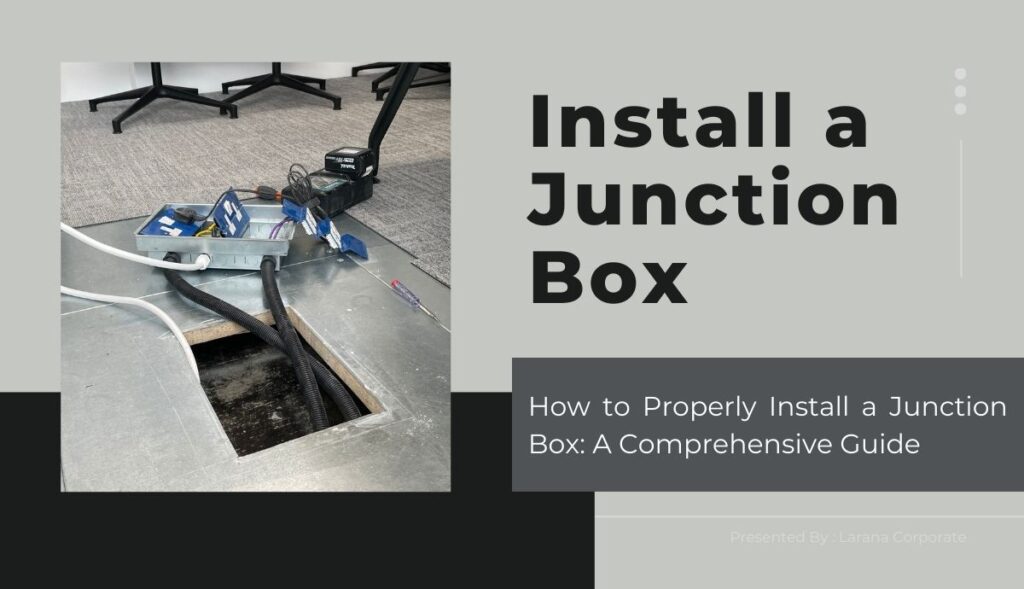In any electrical wiring project, junction boxes play a crucial role in ensuring safe and organised connections. Whether you’re an electrician, a DIY enthusiast, or a homeowner in London, understanding the proper installation of junction boxes is essential. This comprehensive guide will walk you through the process of junction box installation, covering everything from wiring connections to outdoor setups and addressing common queries.
Understanding Junction Boxes
Before we delve into the installation process, let’s define what a junction box is and its purpose. A junction box is an enclosed space that allows for the termination, splicing, and branching of electrical wires. It provides a safe and accessible point for making wiring connections, ensuring compliance with electrical codes and regulations.
When is a Junction Box Required?
- Junction boxes are necessary in various situations, including:
- When splicing or joining electrical cables
- When transitioning from one type of wiring method to another (e.g., from conduit to cable)
- When changing the direction of wiring runs
- When installing light fixtures, switches, or outlets
Types of Junction Boxes
Junction boxes come in different sizes, materials, and configurations to suit various applications. Some common types include:
Plastic Junction Boxes: Lightweight and cost-effective, ideal for indoor applications.
Metal Junction Boxes: Durable and suitable for both indoor and outdoor use.
Weatherproof Junction Boxes: Designed for outdoor installations, providing protection against moisture and environmental elements.
Flush-Mount Junction Boxes: Installed flush with walls or ceilings for a seamless finish.
Step-by-Step Guide to Junction Box Installation
Now that you understand the basics, let’s dive into the installation process:
Step 1: Plan and Prepare
Before beginning any electrical work, ensure that the power supply is turned off at the main breaker or fuse box. Gather all the necessary tools and materials, including the junction box, cables, connectors, and any additional fittings required.
Step 2: Choose the Location
Determine the appropriate location for the junction box, considering factors such as accessibility, proximity to wiring runs, and clearance from obstructions. For outdoor installations, choose a location that offers protection from the elements.
Step 3: Install the Junction Box
Secure the junction box to the desired surface using appropriate fasteners (e.g., screws, nails, or anchors). If mounting on a stud, wood, or masonry surface, ensure the box is securely fastened to prevent movement.
Step 4: Run and Prepare the Cables
Feed the electrical cables into the junction box through the designated openings or knockouts. Leave enough cable length inside the box to make connections comfortably. Strip the sheathing and insulation from the individual conductors, exposing the appropriate amount of bare wire for termination.
Step 5: Make Wiring Connections
Inside the junction box, connect the corresponding conductors (e.g., hot, neutral, and ground) using approved wiring methods and connectors. Follow the established colour coding for proper identification (e.g., brown for live, blue for neutral, and green/yellow for earth).
For junction box wiring connections, you can use various methods, such as:
Wire nuts: Twist-on connectors that securely join multiple wires together.
Terminal blocks: Insulated blocks with individual terminals for terminating wires.
Crimped or soldered connections: Secure and reliable methods for joining wires.
Step 6: Secure and Organise Cables
Once the wiring connections are made, secure the cables within the junction box using cable clamps, strain relief connectors, or cable ties. This prevents undue stress on the connections and ensures a neat and organised installation.
Step 7: Install the Cover
After verifying that all connections are secure and properly insulated, attach the junction box cover using the provided screws or fasteners. Ensure a tight fit to maintain the integrity of the box and protect the connections from external elements.
Wiring an Outdoor Junction Box
When installing a junction box outdoors, additional precautions and considerations are necessary:
- Use a weatherproof or outdoor-rated junction box to protect against moisture, dust, and other environmental factors.
- Seal all cable entry points with appropriate fittings or sealants to prevent water ingress.
- Apply a corrosion-resistant compound to metal boxes and fittings to prevent rust and oxidation.
- Consider using waterproof connectors or junction boxes with built-in gaskets for added protection.
- If the junction box is exposed to direct sunlight or heat, use heat-resistant cables and connectors rated for high temperatures.
Hiring a Commercial Electrician in London
While many homeowners and DIY enthusiasts may feel confident in tackling junction box installation, it’s important to consider hiring a professional commercial electrician in London for more complex or large-scale projects. A qualified electrician can ensure:
- Compliance with local electrical codes and regulations
- Proper installation techniques and safety measures
- Handling of specialised equipment and materials
- Efficient and streamlined project execution
- Professional advice and recommendations for optimal electrical setups
When to Hire a Professional Electrician
Consider hiring a commercial electrician in London for scenarios such as:
- New construction or major renovations
- Complex wiring configurations or high-voltage applications
- Installations in hazardous or challenging environments
- Projects requiring specialised knowledge or certifications
By following these guidelines and seeking professional assistance when necessary, you can ensure that your junction box installation project is completed safely, efficiently, and in compliance with all relevant standards and regulations.
Conclusion
Installing a junction box may seem like a straightforward task, but it requires attention to detail and adherence to proper electrical practices. By understanding the types of junction boxes, wiring connections, and installation techniques, you can ensure a safe and reliable electrical system in your home or commercial property. Remember, when in doubt, it’s always best to consult a professional commercial electrician in London to ensure the highest level of safety and quality workmanship.



